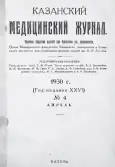To the pathogenesis of anemia in children
- Authors: Krever E.P.1
-
Affiliations:
- Children's Clinic of the State Clinical Institute for Advanced Training of Physicians named after V.I. Lenin
- Issue: Vol 26, No 4 (1930)
- Pages: 346-353
- Section: Articles
- URL: https://bakhtiniada.ru/kazanmedj/article/view/54441
- DOI: https://doi.org/10.17816/kazmj54441
- ID: 54441
Cite item
Full Text
Abstract
Diseases that cause anemia are very diverse, and therefore it is very difficult to classify anemias according to their etiology, and due to various constitutional and other characteristics of the organism, the same cause can cause different phenomena. It is easier to approach the question of the cause of anemia by determining whether erythropoiesis suffers from this disease or whether there is an increased breakdown of red blood cells. In the body, the state of the blood is composed of two processes: on the one hand, erythropoiesis, on the other hand, the decay of erythrocytes. Demonstrative formula Yerringer'a E — R — D (Blutmauserung), where E is the number of erythrocytes, P is their production and D ~ destruction. As long as P balances M, the difference E. remains unchanged. If D, that is, hemolysis, increases more than P, then we get a hemolytic type of anemia. If D — hemolysis remains unchanged, but P decreases — we get an aplastic type of anemia.
Keywords
Full Text
##article.viewOnOriginalSite##About the authors
E. P. Krever
Children's Clinic of the State Clinical Institute for Advanced Training of Physicians named after V.I. Lenin
Author for correspondence.
Email: info@eco-vector.com
Russian Federation, Kazan
References
Supplementary files






